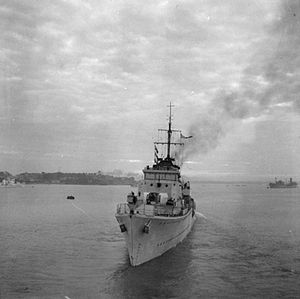HMS Atherstone (L05)

HMS Atherstone in 1942
|
|
| History | |
|---|---|
|
|
|
| Name: | HMS Atherstone |
| Ordered: | 21 March 1939 |
| Builder: | Cammell Laird, Birkenhead |
| Laid down: | 8 June 1939 |
| Launched: | 12 December 1939 |
| Commissioned: | 23 March 1940 |
| Fate: | Sold for scrap 1957 |
| General characteristics | |
| Class and type: | Type I Hunt-class destroyer |
| Displacement: |
|
| Length: | |
| Beam: | 29 ft (8.84 m) |
| Draught: | 7 ft 9 in (2.36 m) |
| Propulsion: |
|
| Speed: | 27.5 kn (50.9 km/h; 31.6 mph) |
| Range: | 2,500 nmi (4,600 km; 2,900 mi) at 20 kn (37 km/h; 23 mph) |
| Complement: | 146 |
| Armament: |
|
HMS Atherstone was a Hunt-class destroyer of the Royal Navy. She was launched in late 1939 as the first of her class but was found to be unstable, and had to undergo significant modifications before entering service in March 1940.
Atherstone was ordered from Cammell Laird of Birkenhead on 21 March 1939, as one of the first batch of ten Hunt-class destroyers. The Hunts were intended to make up for a shortage in destroyer-type vessels, particularly for escort duties. They were to combine the heavy anti-aircraft armament of the Bittern-class sloops (i.e. six 4 inch (102 mm) QF Mk XVI dual purpose (anti-ship and anti-aircraft) guns in three twin mounts) with a speed of 29 knots (54 km/h; 33 mph) (compared with 18 3⁄4 knots (35 km/h; 22 mph) for the Bitterns) to allow them to work with the fleet when necessary. This was supplemented by a close-in anti-aircraft armament of a quadruple 2-pounder "pom-pom", and an anti-submarine armament of 30 depth charges. No torpedo-tubes were to be carried.
Atherstone was laid down on 8 June 1939 and launched on 12 December 1939. An inclining test when the ship was fitting out showed that she, and by extension all the Hunts, was dangerously unstable owing to a design error. To restore stability to acceptable levels, one twin 4 inch mount was removed, the ship's superstructure and funnel was cut down and additional ballast was fitted. Thus modified, Atherstone was completed and commissioned (with the pennant number L05) on 23 March 1940.
Following commissioning and initial trials, Atherstone joined the First Destroyer Flotilla based at Portsmouth employed on convoy escort duties in the English Channel. In June and July, she was detached to the Home Fleet, returning to Portsmouth in August. On 11 September 1940, while escorting Convoy CW11 in the Channel, Atherstone was hit by two bombs and near missed by a third, sustaining serious damage and killing 5 men. After repair at Chatham Dockyard, the ship rejoined the First Destroyer Flotilla in January 1941, resuming convoy escort duty in the Channel. In December 1941, after a refit at Southampton, Atherstone transferred to the 15th Destroyer Flotilla based at Devonport.
...
Wikipedia
